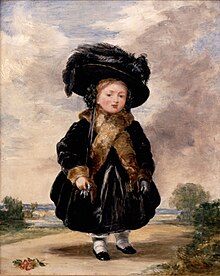Kensington system
The Kensington System (also known as the Kensington Quintet ) is the name given to the procedure with which John Conroy influenced British politics in the years between 1820 and 1837 over a possible British reign of the Duchess of Kent - the mother of the later Queen Victoria wanted to secure.

In addition to Conroy, the so-called Kensington quintet also included the lady-in-waiting of the Duchess Lady Flora Hastings and Victoria's half-brother Karl von Leiningen . This group had three purposes: Victoria's popularity was to be increased by isolating it from the political and moral influences of the royal court, should a reign of the Duchess become necessary to defend it, and to secure John Conroy the position of private secretary to the Queen.
background
The Duchess was mother of Princess Victoria from her marriage to Edward Augustus, Duke of Kent and Strathearn . At the time of her birth, she was fifth in line to the British throne . Her father and his older brothers Georg , Friedrich August and Wilhelm stood before her in the line of succession . The marriage of the British Prince Regent Georg with Caroline von Braunschweig was completely ruined, it was unlikely that legitimate heirs to the throne would emerge from this marriage . Prince Friedrich August died childless in 1827. Prince Wilhelm had no fewer than ten illegitimate children, but his two daughters from his marriage to Adelheid von Sachsen-Meiningen died shortly after their birth.
The Duke of Kent, who died in 1820, almost eight months after the birth of his daughter, had appointed John Conroy as his administrator. This used his role to gain increasing influence on the household of the Duchess of Kent. He bet that the marriages of the Duke's older brothers would all remain childless and that Princess Victoria would succeed on the British throne. Given the old age of the brothers, this would probably be done at a time when the princess was still underage. In this case, the Duchess of Kent would presumably be appointed British regent, who would rule in place of her under-age daughter. This would then secure him influence and power.
In order to secure the influence on the Duchess and their family, it was necessary that they had as little contact as possible with the British royal court. Under George IV this was simple: the king, who had ascended the British throne a few days after the death of his brother, the Dukes of Kent, had been critical of the marriage to Victoria von Sachsen-Coburg-Saalfeld and had loved to see it the Duchess would have returned to Germany with her daughter. When Wilhelm IV ascended the throne in 1830, this changed. He would have liked to see his niece at his court more often. John Conroy prevented this, however. John Conroy's daughter was one of the few playmates of the British heir to the throne: Louise Lehzen remained the princess' tutor , who was little able to prepare the heir to the throne for her role as future monarch. For Princess Victoria, John Conroy's attempt to gain power and influence by influencing her and her mother meant an unhappy and isolated childhood. In 1835 she broke up with her mother because of John Conroy.
As Victoria's 18th birthday approached, there were direct and indirect attempts to subject Victoria to voluntary rule by her mother, even after she came of age. Conroy spread the rumor that Victoria was not mentally stable enough to take responsibility herself.
When Princess Victoria ascended the British throne as Queen Victoria in 1837, John Conroy was not given an official post at court. However, he remained a member of the household of the Duchess of Kent. He lost his post at the Queen's court and received a pension of £ 3,000.
literature
- Carolly Erickson (2001) Queen Victoria. A biography Piper, Munich ISBN 3-492-23286-8 .
- Karl Heinz Wocker (1989) Queen Victoria. The history of an age Heyne, Munich ISBN 3-453-55072-2 .
- Jürgen Lotz (2000) Victoria. Rowohlt Verlag, Reinbek ISBN 3-499-50627-0 .
- Hans-Joachim Netzer (1988) Albert von Sachsen-Coburg-Gotha. A German Prince in England , CH Beck, Munich ISBN 3-406-33000-2 .